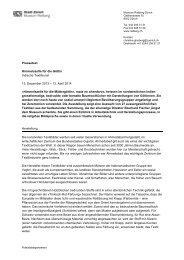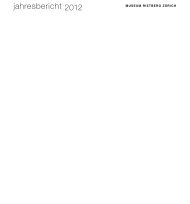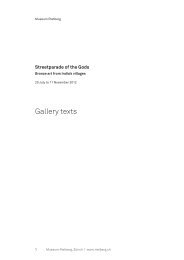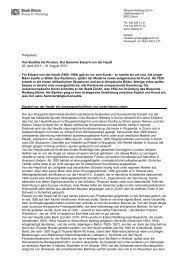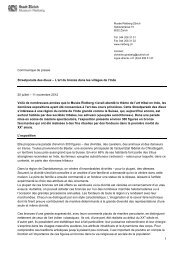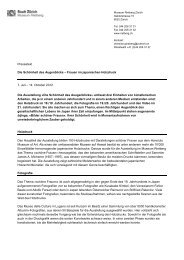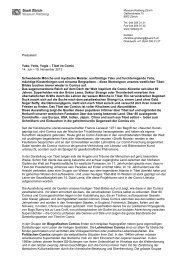1.1 eduard von der heydt - Museum Rietberg
1.1 eduard von der heydt - Museum Rietberg
1.1 eduard von der heydt - Museum Rietberg
You also want an ePaper? Increase the reach of your titles
YUMPU automatically turns print PDFs into web optimized ePapers that Google loves.
3.4<br />
leihgabenpolitik<br />
Von <strong>der</strong> Heydt hatte am Ende des Ersten Weltkriegs<br />
sein gesamtes Vermögen in London verloren. Seither<br />
war er <strong>von</strong> <strong>der</strong> Angst getrieben, dies könnte ihm noch einmal<br />
passieren. Deshalb war er stets besorgt, seine Vermögenswerte<br />
auf verschiedene Firmen und seinen Kunstbesitz auf<br />
Standorte in diversen Län<strong>der</strong>n zu verteilen, um das Verlustrisiko<br />
zu verringern. Nachdem seine Sammlung schnell gewachsen<br />
war, betrieb er ab 1925 eine ausgeklügelte und unvergleichliche<br />
Leihgabenpolitik. Ende <strong>der</strong> 1930er-Jahre hatte<br />
er an nicht weniger als 70 Institutionen Kunstwerke ausgeliehen.<br />
Seine Sammlung umfasste inzwischen rund 2500<br />
Objekte. Die <strong>Museum</strong>sdirektoren, mit denen er häufig einen<br />
intensiven Briefwechsel führte, waren über diese Leihgaben<br />
hocherfreut, zumal ihnen <strong>von</strong> <strong>der</strong> Heydt auch Schenkungen<br />
in Aussicht stellte. Die Leihgaben brachten ihm gewisse<br />
Vorteile: Er erhielt ein Mitspracherecht in den Museen,<br />
seine Werke wurden wissenschaftlich erforscht, und durch<br />
die museale Weihe erhöhte sich ihr Wert.<br />
Bei seinen Käufen und Ausleihen trat <strong>von</strong> <strong>der</strong><br />
Heydt aus steuerlichen Gründen häufig nicht unter eigenem<br />
Namen auf, son<strong>der</strong>n mit dem seiner Bank o<strong>der</strong> einer Finanzgesellschaft.<br />
1938 gründete er eine Aktiengesellschaft, die<br />
<strong>Museum</strong> <strong>von</strong> <strong>der</strong> Heydt N.V., Eysden, in Holland, <strong>der</strong> er sämtliche<br />
Kunstwerke überschrieb. 1940 wurde eine Schweizer<br />
Aktiengesellschaft, die Ratio S.A., Eigentümerin <strong>der</strong> Sammlung.<br />
Damit befanden sich <strong>der</strong>en Eigentumsrechte in <strong>der</strong><br />
Schweiz. Physisch waren zwar noch gewichtige Teile <strong>der</strong><br />
Sammlung in ganz Europa verstreut, viele Werke hatte <strong>der</strong><br />
Sammler jedoch aufgrund <strong>der</strong> nationalsozialistischen Kulturpolitik<br />
bereits aus deutschen Museen abgezogen.<br />
3.4<br />
loan policy<br />
At the end of the First World War, <strong>von</strong> <strong>der</strong> Heydt<br />
had lost his entire fortune in London. From then on he was<br />
driven by the fear that this could happen again. This is why he<br />
always ensured that his investments were distributed among<br />
several companies and that the artworks he owned were kept<br />
in different places in various countries so that the risk of loss<br />
was minimised. After the rapid expansion of his collection,<br />
he had, by 1925, developed a unique and prudent loan policy.<br />
By the end of the 1930s he had loaned artworks to at least<br />
70 different institutions. His collection now included around<br />
2,500 items. The museum directors with whom he often kept<br />
up an intense correspondence were delighted with his loans,<br />
especially since <strong>von</strong> <strong>der</strong> Heydt intimated there might also be<br />
gifts in the future. The loans gave him certain advantages: he<br />
gained influence in the museums, his works were researched<br />
by scholars, and being in a museum increased their value.<br />
For tax reasons, <strong>von</strong> <strong>der</strong> Heydt often did not<br />
make purchases or loans un<strong>der</strong> his own name but used that<br />
of his bank or a company. In 1938, he set up a joint-stock<br />
company in the Netherlands, the <strong>Museum</strong> <strong>von</strong> <strong>der</strong> Heydt N.V.,<br />
Eysden, to which he transferred all his artworks. In 1940, a<br />
Swiss joint-stock company, the Ratio S.A., became owner<br />
of the collection. Thus the rights to the collection were now<br />
in Switzerland. Important parts of the collection were still<br />
physically spread all over Europe but the collector had already<br />
withdrawn many works from German museums because of<br />
the cultural policy of the Nazis.<br />
3.4<br />
politique de prêts<br />
A la fin de la Première Guerre mondiale, Eduard<br />
<strong>von</strong> <strong>der</strong> Heydt avait perdu toute sa fortune à Londres. Dès<br />
lors, il sera poussé par la peur qu’une telle mésaventure ne<br />
se reproduise. C’est la raison pour laquelle il veillera toujours<br />
à répartir ses capitaux entre différentes entreprises<br />
et ses collections d’art entre divers pays, afin de réduire le<br />
risque de perte. Sa collection ayant rapidement atteint une<br />
taille considérable, il pratiqua une politique de prêts raffinée<br />
et unique en son genre à partir de 1925. A la fin des années<br />
1930, il avait prêté pas moins de 70 œuvres d’art à des institutions.<br />
Sa collection comprenait entretemps environ 2500<br />
objets. Les directeurs de musée avec lesquels il entretenait<br />
souvent une abondante correspondance étaient particulièrement<br />
heureux de ces prêts, d’autant plus que <strong>von</strong> <strong>der</strong> Heydt<br />
leur faisait aussi miroiter des donations. Les prêts lui apportaient<br />
en contrepartie certains avantages: il avait son mot à<br />
dire, ses œuvres faisaient l’objet d’analyses scientifiques, et<br />
la consécration du musée faisait augmenter leur valeur.<br />
Souvent, lors de ces acquisitions ou de ces<br />
prêts, Eduard <strong>von</strong> <strong>der</strong> Heydt n’apparaissait pas sous son<br />
propre nom, et ce pour des raisons fiscales, mais sous celui<br />
de sa banque ou d’une société financière. En 1938, il fonde<br />
une société anonyme, la <strong>Museum</strong> <strong>von</strong> <strong>der</strong> Heydt N.V., sise à<br />
Eysden, en Hollande, dont il inscrivit le nom sur toutes les<br />
œuvres d’art qu’il possédait. En 1940, une société anonyme<br />
suisse, la Ratio S.A., devient propriétaire de la collection.<br />
Dès lors, les droits de propriété se trouveront en Suisse. Physiquement,<br />
d’importantes parts de la collection étaient encore<br />
dispersées dans toute l’Europe, toutefois, en raison de la<br />
politique culturelle nazie, le collectionneur avait déjà retiré<br />
bon nombre de ses œuvres des musées allemands.<br />
Völkerkundemuseum München, Von <strong>der</strong> Heydt-Leihgaben (loans from <strong>von</strong><br />
<strong>der</strong> Heydt / prêts de <strong>von</strong> <strong>der</strong> Heydt), 1936 (<strong>Museum</strong> <strong>Rietberg</strong> Zürich, Archiv)<br />
Metropolitan <strong>Museum</strong>, New York, Von <strong>der</strong> Heydt-Leihgaben (loans from <strong>von</strong><br />
<strong>der</strong> Heydt / prêts de <strong>von</strong> <strong>der</strong> Heydt), 1925 (<strong>Museum</strong> <strong>Rietberg</strong> Zürich, Archiv)






